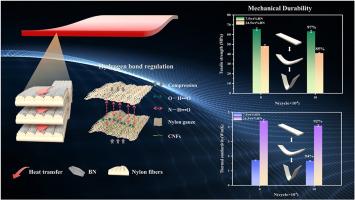具有优异机械耐久性的导热复合材料的纤维素纳米纤维界面工程
IF 9.8
1区 材料科学
Q1 MATERIALS SCIENCE, COMPOSITES
引用次数: 0
摘要
纤维素纳米纤维(CNFs)来源于可再生生物质,具有优异的机械性能、高长径比和丰富的表面羟基,使其在聚合物复合功能化方面具有很高的吸引力。在这项研究中,CNFs被用作分散剂和增强剂,以解决尼龙基导热复合材料中填料聚集和界面粘附不良的双重挑战。CNFs利用其强大的氢键能力,不仅使氮化硼(BN)填料在水体系中均匀分散,而且有助于在聚合物基体中构建坚固的界面网络。使用简单的真空辅助过滤和压缩成型策略,我们制造了具有高度排列BN结构的层压复合材料。这种独特的结构促进了高效热通道的形成,导致在24.5% wt% bn时的面内导热系数为4.5 Wm−1K−1,比纯尼龙提高了1857%。同时,cnf诱导的界面增强带来了优异的机械强度和抗疲劳性能,在10万次弯曲循环后,复合材料保持了92%的导热系数和85%的抗拉强度。这些发现证明了cnf辅助界面工程在开发适用于柔性电子和其他先进应用的高性能热塑性热管理材料方面的巨大潜力。本文章由计算机程序翻译,如有差异,请以英文原文为准。

Cellulose nanofibers-enabled interfacial engineering for thermally conductive composites with superior mechanical durability
Cellulose nanofibers (CNFs), derived from renewable biomass, offer exceptional mechanical properties, a high aspect ratio, and abundant surface hydroxyl groups, making them highly attractive for polymer composite functionalization. In this study, CNFs are employed as both dispersing and reinforcing agents to address the dual challenges of filler aggregation and poor interfacial adhesion in nylon-based thermally conductive composites. By leveraging their strong hydrogen bonding capability, CNFs not only enable the uniform dispersion of boron nitride (BN) fillers in aqueous systems but also facilitate the construction of robust interfacial networks within the polymer matrix. Using a simple vacuum-assisted filtration and compression molding strategy, we fabricated laminated composites featuring highly aligned BN structures. This unique architecture promotes the formation of efficient thermal pathways, resulting in an in-plane thermal conductivity of 4.5 Wm−1K−1 at 24.5 wt% BN—an 1857 % enhancement over pure nylon. Simultaneously, the CNF-induced interfacial reinforcement leads to excellent mechanical strength and fatigue resistance, with the composite retaining 92 % of its thermal conductivity and 85 % of its tensile strength after 100,000 bending cycles. These findings demonstrate the significant potential of CNF-assisted interfacial engineering for developing high-performance, thermoplastic-based thermal management materials suitable for flexible electronics and other advanced applications.
求助全文
通过发布文献求助,成功后即可免费获取论文全文。
去求助
来源期刊

Composites Science and Technology
工程技术-材料科学:复合
CiteScore
16.20
自引率
9.90%
发文量
611
审稿时长
33 days
期刊介绍:
Composites Science and Technology publishes refereed original articles on the fundamental and applied science of engineering composites. The focus of this journal is on polymeric matrix composites with reinforcements/fillers ranging from nano- to macro-scale. CSTE encourages manuscripts reporting unique, innovative contributions to the physics, chemistry, materials science and applied mechanics aspects of advanced composites.
Besides traditional fiber reinforced composites, novel composites with significant potential for engineering applications are encouraged.
 求助内容:
求助内容: 应助结果提醒方式:
应助结果提醒方式:


